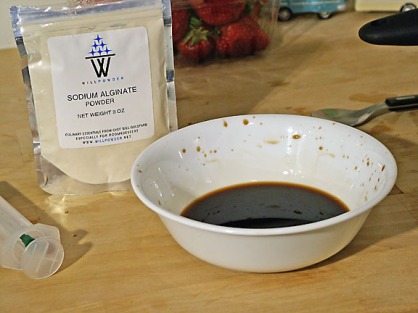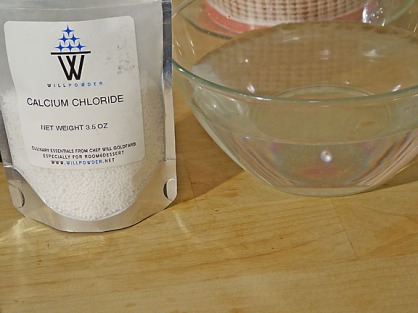Most people who know me know that I love to cook. A while ago I learned about El Bulli, a restaurant located on Spain’s Costa Brava. It is repeatedly voted the best and most innovative restaurant in the world and is lead by sort of a mad scientist chef named Ferran Adria who combines the deterministic knowledge of science with the art of cooking to create what has become known as Molecular Gastronomy. He frequently uses industrial food ingredients in innovative ways to form edible art. One of his most famous inventions is “El Bulli” style caviar. This caviar is formed by combining a flavored liquid with Sodium Alginate. This mixture is then dropped one drop at a time into a solution of Calcium Chloride. When the drop hits the solution, the strong attraction of the Chloride ions pulls the Sodium ions out of the caviar liquid. This void is then replaced by the Calcium ions which have a 2+ charge instead of a 1+ charge like the Sodium. This increase in the charge causes an instantaneous cross linking of the Alginate polymers causing the drop to solidify into something that looks a lot like caviar; only it is flavored what ever the original liquid was.
Here, I create a dessert Nigiri with Strawberries and caviar made from Balsamic vinegar. First, gather the ingredients. You will need Balsamic vinegar and some sweet Mirin for the caviar liquid, some large Strawberries, and a bowl of water with a strainer that can fit inside of it. You will also need a “flavor injector” type food syringe which you can buy at most any well stocked cooking store.
You will also need some pretty unique ingredients which you can order from Will Powder. They are food grade Sodium Alginate, Calcium Chloride, and Sodium Citrate. For the caviar liquid you will want about a half cup or so of Balsamic vinegar and a tablespoon of sweet Mirin to add some sweetness. To this liquid, first add a teaspoon of Sodium Citrate. Alginate dosen’t work optimally in acidic liquids so you add this as a buffer to get a more neutral pH. Next, get a teaspoon or so of the Sodium Alginate and very slowly wisk it into the liquid. You should only add a little bit at a time otherwise the powder will clump into one big ball.
Now, prepare the Calcium Chloride solution by dissolving a heaping teaspoon of it into a pint or so of cold water.
Suck the caviar liquid up into the syringe and move over to the Calcium Chloride solution. Position the tip of the syringe about an inch above the surface of the solution. If it is too low, drops will not form properly and if it is too high the impact of the drop on the surface will distort the drop into a flat disk. Drop by drop, add the liquid into the solution. Leave for a few minutes and you will have Balsamic caviar.
Remove the caviar with the strainer and rinse gently under cold water.
Make Nigri pieces with sushi rice and rub a little Wasabi on them (trust me, it works).
Then add some thin slices of Strawberry and top with the caviar. Presto, an innovative, unique dessert!
I can tell right about now that you are asking “This is a blog about sustainable biotechnology. What could dessert sushi possibly have to do with sustainable biotechnology?” It turns out that it has a whole lot to do with it! Immobilization of cells and enzymes in bioprocessing units is an active area of research. This immobilization facilitates easier handling of the cells or enzymes including bioseperations. In the latest Journal of Industrial Microbiology, a team if Chinese researchers reports on a diesel fuel desulfurization process using exactly Sodium Alginate “caviar”(1). New regulations for diesel fuel require strict limits on the amount of sulfur compounds that can be present in the fuel. This team used Pseudomonas delafieldii bacteria isolated from the waste pools of Chinese oil fields which eat the sulfur in diesel fuel. They made the Alginate spheres containing this bacterium instead of Balsamic vinegar. This allowed desulfurization of the fuel while allowing easy separation and decontamination of the fuel once the process is complete. There are a bunch of other applications of immobilization of cells and enzymes out there which I will leave to the reader’s curiosity.
References
(1) Improvement of biodesulfurization activity of alginate immobilized cells in biphasic systems. Y.G. Li, J.M. Xing, X.C. Wong, W.L. Li, H.S. Gao, H.Z. Liu, Industrial Microbiology & Biotechnology, Volume 35 Number 3.





